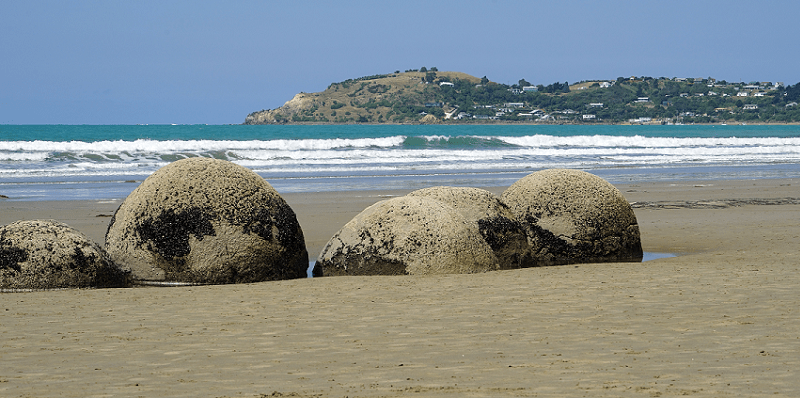
Moeraki Boulders Facts
- Perhaps most notably, the truly astounding Moeraki Boulders comprise an extraordinarily unusual geological feature. That holds true due to a fascinating occurrence. It’s also an extremely rare combination of factors, setting it clearly apart.
- Its story begins seemingly simply enough, deceptively. That’s because the feature consists of a rather startling collection of large boulders. These large objects also lay along a section of beach in a particularly remote part of the world.
- Somewhat distinctively, the great majority of the highly surprising boulders lie tightly grouped in relatively large clusters. This remarkable positioning of the boulders only serves as the beginning of the distinctiveness of this feature, though.
- Also, and unfortunately, this magnificent example of the variability and unpredictability of nature appears to be slowly vanishing. This disturbing fact constitutes a potential loss for those who appreciate the wonders and marvels of our world.
- The renowned W. B. D. Mantell sketched this remarkable natural formation in the year 1848. At that time, however, many more of the amazing Moeraki Boulders existed. This marked the first known sighting of the geological feature by a European.
- The locally indigenous Maori, however, had long known of their existence. No records exist of their first sighting of the tantalizing structures. Fortunately for posterity, the section of beach that they appear on now forms a protected reserve.
Related Articles
Moeraki Boulders Physical Description
Truly unsurprisingly, the eye-catching Moeraki Boulders have long fascinated those who encounter them. This fascination further includes the sheer physical form and variety of the structures. The great majority of these stones actually fall into two distinct size ranges.
Approximately 30% of these natural geological marvels measure somewhere between 1.6-3.3 ft (0.5-1.0 m) in diameter. Meanwhile, the vast majority of the rest all stay in the range of 4.9-7.2 ft (1.5-2.2 m). Very few specimens fall outside of these two size ranges.
Most of these unique objects additionally display another mutual characteristic. These display a roughly spherical shape. Nevertheless, a comparatively small percentage of them possess a slightly elongated shape. The reason for the difference remains unknown.
Some of these geological marvels also possess large fissures, as well. Yet all of the perplexing Moeraki Boulders do have one basic factor in common. All of the fabulous boulders display a dark gray color, due to the particular nature of their composition.
Moeraki Boulders Location, Composition, and Origin
As will come as no surprise to those who appreciate such things, mysteries still surround the incredible Moeraki Boulders. Perhaps this is fitting, given that the objects formed in an area of the world renowned for the splendor and variety of its natural environment.
That’s because these fascinating and remarkable geological wonders formed in what now constitutes the beautiful country of New Zealand, off the coast of Australia. Yet, while many mysteries surround them, researchers do know some facts about these marvels of Nature.
For one, the incredible structures formed long ago, as what’s known to science as septarian concretions. Plus, each of them consists of a highly specific combination of elements. These materials include portions of silt, clay, and mud, bonded together by calcite.
Beneath the extremely hard outer shell, they remain relatively soft, as they are less compacted. A few have also broken open, and their interiors eroded by the elements. Impressively, the inner cores of many of these formations have linings of calcite crystals.
The Moeraki Boulders formed during the Paleocene Era as calcite deposited in the mud on the seafloor. As further mud layers deposited, the pressures began their formation. The process required millions of years. Coastal erosion then exhumed them from the sea mud.
Features Sharing Its Region
Check out our other articles on 7 Astounding Polar Creatures, Black Rain Frog, Borra Caves, Living Stones, California Sea Lion, Kakapo, Giant Trevally, Komodo Dragon, European Hornet
